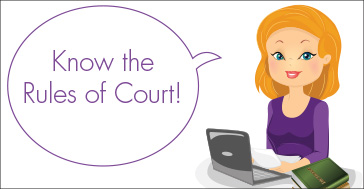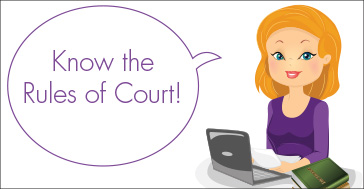This month we highlight tips from Dennis Hanshew, a paralegal with Blacker, Sammis & Blacker; Commissioner Marjorie Slabach, a private judge and retired commissioner in the Family Law Department of the San Francisco Superior Court; Scott Herndon, a toxic torts, business litigation, and employment law attorney with Sinunu Bruni; and David Blacker, a partner in Blacker, Sammis & Blacker. Blacker handles high asset cases and matters involving same sex relationships, paternity, and custody.
The four shared their views at an October 26 panel discussion presented by BASF’s Paralegal Section.

David Hanshew reviewed rules from the California Rules of Court that we would do well to remember. First and foremost, Rule 2.100 provides that the California Rules concerning the form and formatting of briefs preempt any local rules. Rule 2.104 dictates a font size of no smaller than 12 point. While the style of the text may be Courier, Arial or Times New Roman (Rule 2.105), Times New Roman is the most space-efficient, Hanshaw said. Unless the court permits a longer filing under the terms of Rule 3.113 (e), opening and responding briefs must not exceed 15 pages (except for those filed for or against summary judgment, in which case 20 pages is allowed), and a Reply must not exceed 10. (Rule 3.113 (d).)
A brief, however, does not have to be double-spaced. Under CRC 2.108, the lines may be one and a half spaced. This rule can come in handy when struggling to stay under the page limit.
Finally, a footer should appear below the page number at the bottom of each page of text—containing the title of the paper. A “clear and concise” abbreviated form is allowed. Hanshew recommended also including the name of the case and the case number in the footer, as pages can get separated. Text in the footer may be in 10-point type. (Rule 2.110.)
As for writing and editing, Hanshew stressed the importance of avoiding double negatives and “posturing” words (like “flagrantly” or “graciously”), and leaving time to double check dates and scout for wrong words. David Blacker picked up on this point, and recommended giving the paralegal time to review the brief for understandability and persuasiveness.
Commissioner Slabach offered her ten commandments for legal brief writing. (See list, at bottom.) She also said a brief writer should put her best argument first, in case the judge does not have time to read the rest, and advised against “ask[ing] for the moon” as a strategy for getting a more minor request granted.s, and attach exhibits or graphs only when necessary);
Herndon identified the intro as the most important part of a brief—the place to “bring [the judge] into the document,” and “encapsulate what it is you’re after and what your argument is … [in] a really focused way.” To convey a complex idea, use a series of simply constructed sentences. “Get rid of the idea that you have to do all of your intellectual work in one sentence,” he said.
As we have in this column, Blacker advised against “jump[ing] into writing. Get away from the computer,” he said. “Spend a lot of time thinking about what you’re seeking and how you want to present you arguments.” Blacker also said we should not “hide from the weakness of the case,” as we should focus the judge’s attention on how we have overcome any flaws or deficiencies in our position.
And that, he said, is really what legal writing is about.
Ret. Judge Marjorie Slabach’s 10 commandments for writing briefs to the court:
- Focus on your audience: It’s the judge, not opposing counsel or party;
- Take pity on an old pair or eyes and follow the rules about font and space (She prefers 14-point type);
- Understand the judge has 20 other files to review for the calendar—keep it short (Don’t feel like you have to use as many pages as the rule allows, and attach exhibits or graphs only when necessary);
- Start with telling the judge exactly what you want her to do/what ruling you want (The worst thing you can hear her say is, “I really don’t know what you’re asking for”);
- Tell the story in short, concise sentences;
- Do not use long-winded sentences that lose the subject and verb two pages back;
- Point out agreements with opposing counsel (“Let me know what issues I can set aside,” Judge Slabach says);
- Cite cases correctly (and appropriately): Do NOT tell the judge the case stands for this when it stands for that (“You want me to trust you,” she says);
- Stay positive: Do not bicker with and blame opposing counsel or party;
- Close with a short concise reminder of the exact ruling you want the judge to make.
About the Author:
Attorney Savannah Blackwell is a former news reporter who covered government and politics for more than a decade, mostly in San Francisco. She can be reached at savannah.blackwell@gmail.com. Follow her on Twitter at @SavannahBinSF.


